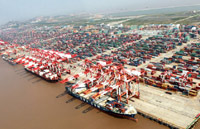Rising Chinese consumer power to lift commodities
(Agencies) Updated: 2015-01-16 08:11Metals demand to soar this year as Chinese demand for appliances continues to grow, reports Bloomberg.
China's move away from a heavy industrial economy has led to bear markets in everything from iron ore to coal. It has also created opportunity in the sometimes overlooked minerals that will feed its next phase of growth.
Those materials include bauxite-the ore that is used to make aluminum-and the zinc, copper, natural gas and uranium used to make or power the millions more washing machines, air conditioners and cars that China's 1.4 billion consumers are forecast to demand.
"We are seeing a transition," said Michael Elliott, sector leader for Ernst & Young LLP's global mining practice, from Sydney. "We'll see aluminum make a bit of a resurgence, copper will clearly be there and probably zinc will continue to rise."
China has already surpassed Japan as the world's largest consumer market after the United States, according to Euromonitor International. It forecasts that about 90 percent of Chinese households-or 470 million-by 2030 will have annual disposable income of $15,000 or more, compared with 133 million households in the US.
The change is welcome news for mining companies that have been battered by the collapse in prices for the bulk commodities used to make the steel that drove China's most recent phase of growth.
Rio Tinto Group, the world's second-largest miner, is slowing spending in iron ore and coal, while flagging increased investment in copper and bauxite from this year. BHP Billiton Ltd sees electricity consumption driving demand growth in China for copper and is expanding mines.
China's shift to consumption-led growth is part of a dramatic change that will offer a "fantastic opportunity" to the developed world, according to Stephen Roach, former chief economist at Morgan Stanley.
The nation already accounts for about half of all global sales of small appliances from vacuum cleaners to cooking devices, according to Euromonitor.
A typical washing machine contains about 7 kilograms of aluminum and 2 kg of copper, putting those among the commodities on the upswing. Refrigerators typically have about 7 kg of copper and 4 kg of aluminum. A typical home needs around 125 kg of copper in wiring, tubes and other hardware.
The metal is forecast to jump 21 percent in price this year, according to median price forecasts for 2015 compiled by Bloomberg. China's copper imports climbed to a record in 2014, according to Customs data.
Aluminum is predicted to climb by 16 percent this year and zinc by 13 percent, the forecasts show. In contrast, Citigroup Inc expects iron ore may fall a further 15 percent this year.
China itself has already shown the way. Two years ago, a unit of CITIC Group Corp, the nation's biggest conglomerate, made an almost unnoticed investment in obscure Australian miner Alumina Ltd.
It was not lost on CITIC that Alumina plays a key role in the $76 billion aluminum market and buying the near 14 percent stake in the joint venture with Alcoa Inc gave it slice of the world's biggest bauxite and alumina producer with operations across five continents.
- China changes rules of calculating lending, deposits
- The retired need wider investment channels
- Johnson & Johnson has the right formula for growth in China
- Hong Kong's house prices expected to be flat in 2015
- China retains global top spot for clean energy investment
- University students design solar-powered drone
- Chinese banks given nod to start asset-backed securities sales
- Rising consumer power to lift commodities

















